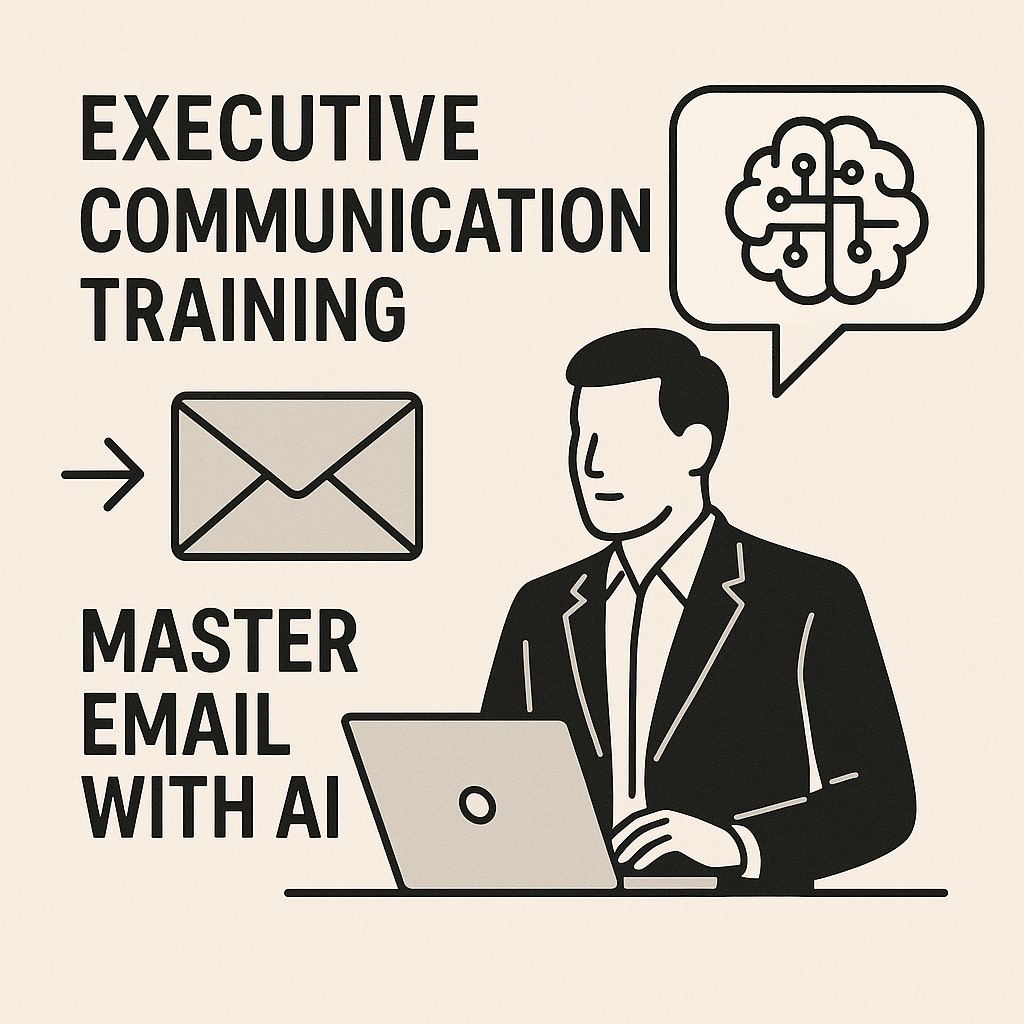Executive Communication Training: Master Email with AI

In today's hyper-connected business environment, executives are constantly navigating a deluge of information. While new communication platforms emerge with dazzling speed, one channel remains the bedrock of professional interaction: email. For leaders, mastering this ubiquitous tool isn't just about managing a daily task; it's a critical component of effective executive communication training and a significant lever for executive productivity. The challenge, however, lies in transforming email from a potential time sink into a strategic asset. This is where a data-driven approach, amplified by artificial intelligence, offers a powerful new paradigm for leaders seeking to enhance their leadership communication skills and drive better business outcomes.
The Evolving Landscape of Executive Communication
The digital age has democratized communication, offering a smorgasbord of tools from instant messaging apps and video conferencing to project management platforms. Yet, email endures. It serves as the official record, the primary vehicle for formal requests, detailed explanations, and broad announcements. For executives, the inbox is often the central nervous system of their operations, a constant stream of critical updates, urgent requests, and opportunities for engagement. However, the sheer volume can be overwhelming, leading to missed messages, delayed responses, and a significant drain on valuable executive time. The ability to cut through the noise, communicate with clarity, and ensure messages land with impact is no longer a soft skill—it's a core competency in modern leadership.
Why Email Still Reigns Supreme for Executive Communication
Despite the rise of more immediate communication methods, email retains its primacy for several key reasons:
- Formal Record Keeping: Email provides a documented trail of conversations, decisions, and agreements, which is invaluable for accountability and future reference.
- Asynchronous Advantage: It allows recipients to engage with messages at their convenience, respecting different time zones and work schedules, which is crucial for global leadership.
- Breadth of Reach: Email can efficiently reach large, segmented audiences, making it ideal for company-wide announcements or client outreach.
- Depth of Detail: Complex information, attachments, and detailed proposals are best conveyed and managed through email.
- Professional Gravitas: For official communications, proposals, and critical updates, email carries a level of formality and importance that other channels often lack.
For busy executives, understanding the nuances of email etiquette and efficiency is paramount. It's about more than just sending messages; it's about strategic communication that influences, informs, and drives action. This makes robust executive communication training focused on email essential for any leader aiming for peak performance.
The Data-Driven Advantage: Applying Decision Science to Your Inbox
The concept of data-driven communication shifts the focus from intuition to empirical evidence. By applying principles of decision science for communication, leaders can move beyond guesswork and begin to understand what truly makes their messages effective. This involves analyzing patterns in how communication is sent, received, and acted upon. For instance, understanding response times, the clarity of calls to action, and even the perceived tone of messages can reveal hidden inefficiencies or areas for improvement.
Imagine knowing which types of subject lines yield higher open rates for specific recipients, or how the length of your email impacts engagement. This level of insight allows for continuous refinement of your communication approach. Tools that offer email insights: drive decisions with your inbox data can provide this granular visibility. By treating your inbox not just as a communication channel but as a rich source of behavioral data, you can make informed decisions about how you communicate, who you communicate with, and when. This analytical approach is key to optimizing your business email optimization efforts and enhancing overall executive productivity.
Key Pillars of Effective Executive Email Communication
Mastering executive email requires a focus on several foundational pillars. These elements, when consistently applied, ensure that your messages are not only received but also understood and acted upon, reinforcing your leadership communication skills:
1. Clarity and Conciseness: * Get to the Point: Executives are pressed for time. State your purpose upfront, ideally in the first sentence. * Use Short Paragraphs and Bullet Points: Break up dense text to improve readability and highlight key information. * Avoid Jargon: Use clear, straightforward language that everyone can understand.
2. Actionability: * Clear Call to Action: What specific action do you want the recipient to do? Make it unambiguous. * Defined Deadlines: If a response or action is time-sensitive, clearly state the deadline. * Provide Necessary Context: Ensure recipients have all the information they need to act.
3. Tone and Professionalism: * Maintain Professional Demeanor: Even in informal exchanges, uphold a professional tone that reflects your leadership position. * Proofread Meticulously: Typos and grammatical errors can undermine your credibility. * Empathy and Respect: Consider the recipient's perspective and communicate with respect.
4. Timeliness and Responsiveness: * Manage Expectations: If you can't respond immediately, a brief acknowledgment is often appreciated. * Prioritize Urgency: Develop a system for identifying and addressing high-priority emails quickly. * Set Boundaries: While responsiveness is key, learn to manage your inbox to avoid constant interruption.
5. Subject Line Mastery: * Be Specific: A clear subject line helps recipients prioritize and find emails later. * Indicate Urgency (If Applicable): Use prefixes like "URGENT" or "ACTION REQUIRED" sparingly and appropriately. * Keep it Brief: Ensure the subject is visible on mobile devices.
By focusing on these pillars, executives can significantly improve their business email optimization and make their communication more impactful.
Leveraging AI for Smarter Executive Email Management with MailToPie
The integration of Artificial Intelligence (AI) is revolutionizing how executives manage their digital communications, offering unprecedented gains in executive productivity and efficiency. AI-powered tools can automate repetitive tasks, provide intelligent insights, and even help craft more effective messages. This is a significant advancement in AI in leadership, equipping leaders with powerful allies in their daily workflow.
Modern tools are redefining how executives manage their digital correspondence. For instance, an ai executive assistant can drastically reduce the time spent on drafting, sorting, and responding to emails, freeing up valuable cognitive load for strategic thinking. These assistants can learn your communication style, summarize lengthy threads, flag important messages, and suggest replies, thereby streamlining your entire email workflow. For executives looking to enhance their leadership communication skills and manage their overflowing inboxes, leveraging such technology is no longer optional; it’s a competitive advantage. As noted in resources like Zendesk Training's guide on Mastering AI Agents for Email Automation, building a foundational understanding of these tools is key.
Consider the potential: AI can analyze recipient engagement patterns, offering insights into what makes your messages more effective. It can help optimize message delivery by suggesting the best times to send or providing feedback on clarity and tone. Platforms that offer comprehensive AI email solutions: master your inbox with smart management are at the forefront of this shift, transforming email from a chore into a strategic tool. This capability aligns with the broader trend of using AI for competitive intelligence, as seen in discussions around AI talking to AI: Your Edge in Competitor Intelligence, where understanding communication patterns is key.
Furthermore, AI can assist in managing the sheer volume and complexity of modern email. Tools like AI Copilot in Microsoft Outlook, as highlighted by NACVA's training programs, demonstrate how AI can accelerate drafting and organization. Similarly, resources like those from Superhuman, discussing how executives can use AI to draft emails in seconds, showcase the practical applications of AI in expediting communication tasks. This allows executives to focus on high-level strategy rather than getting bogged down in the minutiae of email management.
Actionable Strategies for Improving Executive Email Productivity
Beyond leveraging AI, adopting smart email management strategies is crucial for boosting executive productivity. Here are several actionable techniques:
- Time Blocking for Email: Instead of checking email constantly, dedicate specific blocks of time each day to process your inbox. This minimizes context switching and improves focus.
- Batch Processing: Handle similar email tasks together. For example, respond to all non-urgent emails at once, archive processed messages, and flag items requiring further action. This is a core concept in effective email task management: AI for actionable insights.
- Delegate When Possible: If an email doesn't require your direct attention, delegate it to a team member who can handle it. Clearly define the task and expected outcome.
- Utilize Templates and Canned Responses: For frequently asked questions or common replies, create templates to save time and ensure consistency.
- Master Keyboard Shortcuts and Email Client Features: Become proficient with your email client's features, such as quick parts, rules, and filters. For those using Gmail, learning advanced techniques for managing gmail can yield significant time savings.
- Inbox Zero Philosophy: Aim to clear your inbox regularly. Process, delegate, defer, or delete each email. This keeps your workspace clean and your mind clear.
- Focus on Actionable Emails: Train yourself and your team to make emails actionable and easy to process. This includes clear subject lines and a single, clear call to action per email.
Implementing these strategies, often supported by AI, can dramatically reduce the time spent on email and increase the effectiveness of your communication.
Measuring Success: Data-Informed Metrics for Communication Effectiveness
To truly transform your email communication, you need to measure its effectiveness. This is where data-driven communication becomes indispensable. Instead of relying on subjective feelings of busyness, you can track objective metrics to gauge your progress and identify areas for refinement. Key metrics include:
- Response Time: How quickly are you or your team responding to important emails? AI tools can help track and even automate initial acknowledgments.
- Clarity of Action Items: Are recipients clear on what needs to be done after reading your email? This can be indirectly measured by the number of follow-up clarification emails or the success rate of the requested action.
- Reduction in Back-and-Forth: Effective emails resolve issues in fewer exchanges. Tracking the number of emails required to complete a task can indicate improved clarity and completeness.
- Time Saved: Quantify the time saved by using AI assistants or implementing new email management strategies. This directly contributes to executive productivity.
- Engagement Metrics: While not always directly available, proxy metrics like task completion rates from email requests or positive feedback can indicate message impact.
By regularly reviewing these metrics, executives can fine-tune their approach, ensuring their communication is not just efficient but also highly effective. This data-informed perspective is crucial for continuous improvement, much like optimizing business processes through analytics. For those in highly regulated industries, ensuring compliance, such as with HIPAA compliant email services, also involves meticulous tracking and auditing of communications.
Conclusion: Becoming a Data-Driven Communicator
The journey to mastering executive communication, particularly through email, is an ongoing process of learning and adaptation. In an era defined by information overload, the ability to communicate clearly, concisely, and effectively is a hallmark of strong leadership communication skills. By embracing a data-driven communication approach and leveraging the power of AI, executives can overcome the challenges of their overflowing inboxes and transform email into a strategic asset.
AI tools, such as advanced email solutions, and specifically an ai executive assistant, offer practical ways to enhance executive productivity and achieve superior business email optimization. They provide the insights and automation needed to refine communication strategies, ensuring messages achieve their intended impact. As highlighted by experts discussing Using AI to Enhance Your Email Communication as a Leader, integrating these technologies is key to future-proofing your leadership effectiveness.
Ultimately, becoming a data-driven communicator means continuously seeking to understand, refine, and optimize how you interact with others. It's about making informed decisions that improve clarity, efficiency, and impact. By investing in your executive communication training and embracing the intelligent capabilities of AI, you can elevate your leadership, drive better decisions, and foster a more productive and communicative organization. This strategic approach to communication is fundamental to thriving in the modern business landscape.



